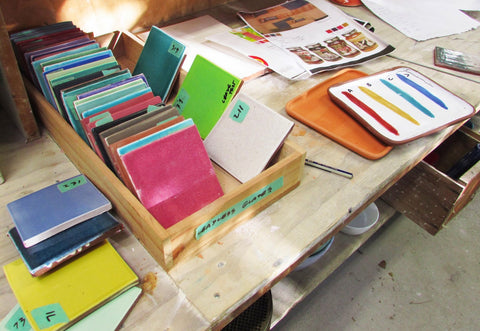
Over the thirty years that Morris & James has been making pottery, we have put together an enormous range of glazes. Some of these are standard ‘off-the-shelf’ formulas, others are our own concoctions! Each one is formulated and documented by our chemist, Mike Rose, who has been with the business for many, many years and is an expert in making glazes that meet our technical and creative needs.
Working with feedback from the decorators and our design team Mike is constantly tweaking existing glazes to produce an ever growing range of colours, some of which are selected and become part of our standard selection. There are so many possibilities that for practical reasons we have to limit the number that we use on a day-to-day basis. Glaze chemistry is both an art and a science; sometimes the science whilst being theoretically predictable simply does not play by the rules! There are many subtle variables that can confound our best efforts. Most recently we experienced an unexpected and unwelcome change to one of our most popular and long standing glazes, Hollyberry.
A popular but expensive bright red glaze, we use it widely as both a base and for detailing. The photos don’t really do justice to the depth of colour and particularly the subtle ‘texture’ that is evident when viewed closely. Recently however, for reasons we have yet to fully understand, the surface of this usually very stable glaze has on occasion become ‘milky’. Under the microscope you can see that this is caused by very small bubbles trapped in the upper layer of the glaze, which interferes with the colour character. But knowing the mechanics of a problem is not quite the same as knowing how to fix it! The supplier was originally based in Portugal but had recently relocated to Spain, and we wondered if along the way there had been a change in the formulation.
However, Mike has eliminated this and at the moment the most likely cause is a settling out if the glaze is allowed to stand and not mixed thoroughly before use. In the meantime, we continue to explore alternatives and additions, constantly refining our palette. Some recent additions that compliment contemporary trends are being used on the new Oceania range, which because of its simplicity of form lends itself to a more subtle surface treatment.
- Nick C

Left: Large bubbles
Center: (20X) Cross section teracotta/engobe/glaze
Right: mass of small bubbles




